#the buyerarchy of needs
Text
The Buyerarchy of Needs
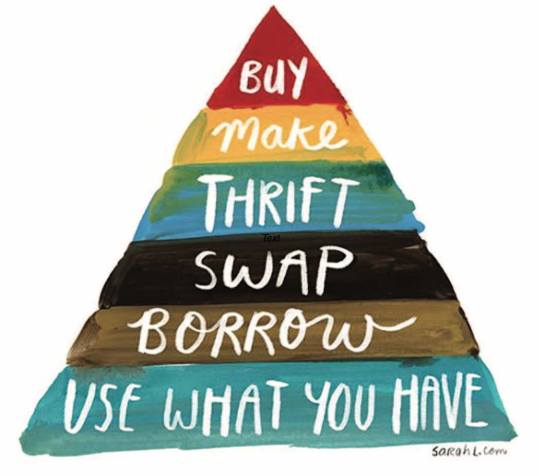
made by Sarah Lazarovic, from her book “A Bunch of Pretty Things I Did Not Buy” ^-^
#saw this on pinterest and felt it should be spread around#i think ive seen this once on here ? still#the buyerarchy of needs#buyerarchy of needs#sustainability#ecopunk#eco punk#solarpunk#environmentalism#sustainable fashion#edited to include full credit 👍👍
738 notes
·
View notes
Text
The Rise of the Buyerarchy (of Needs)
The Buyerarchy of Needs was coined by Creative Director, Author, and Behavioral Scientist Sarah Lazarovic, and dates back to her 2014 book, A Bunch of Pretty Things I Did Not Buy. For a full year, instead of buying things, she just drew pictures of the things she wanted and then wrote about the exercise in minimalism. This wonderfully illustrated book pushes back against consumerism and advocates…
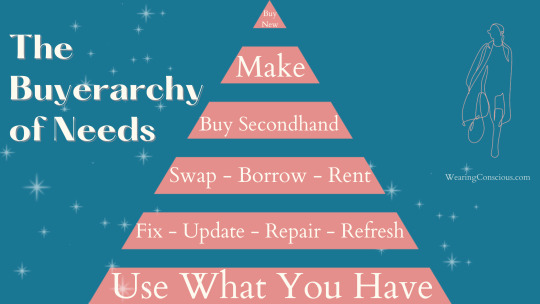
View On WordPress
0 notes
Photo

I have found so many art supplies that I’ve purchased and half used over the years, so I’m using what I have and making myself handly reminders to hang up in my apartment.
9 notes
·
View notes
Text
The Buyerarchy of Needs
Being the design and manufacturing of high volumes of low-quality clothing at a rapid rate of production, fast fashion is a means of bringing inexpensive styles to the public using trend replication. Despite being a recent phenomenon, fast fashions rapid development over a short period of time is extremely concerning from a sustainability point of view, as these cheaply made, trendy pieces result in an overwhelming amount of consumerism, while harmfully impacting the environment, garment workers, and ultimately, the consumer and their wallets. This fast fashion nightmare is being combatted daily, with the likes of boutique owners and designers Chrissy Adams, and Ilah and Tracy challenging its every move by promoting slow fashion, buying second hand, and everything in between.
According to Audrey Stanton, slow fashion is a direct response to fast fashion, and is a “thoughtful, intentional, and holistic” approach to excessive manufacturing, overcomplicated supply chains, and senseless consumption. The term slow fashion was first coined as a means of defining the ideal that having quality-based clothing over time-based clothing is far more advantageous for both the consumer and the environment. Slow fashion encourages slower production, and ultimately invites consumers to invest in quality clothing, as a means of building a minimalist wardrobe that will last a lifetime. Because fast fashion companies launch new collections almost weekly, slow fashion obviously aims to promote the opposite of this. Essentially, slow fashion boasts slower production schedules, small-batch collections, and zero waste designs, as a means of reducing textile waste. Rather than following micro trends and seasons, slow fashion labels utilise enduring styles and create classic, versatile pieces, created in-house or locally, as a means of ensuring that the supply chain process and labour conditions align with global standards. The idea of purchases benefitting not only the individual, but the environment and those who are slaves to the industry, has begun to become more appealing to buyers, as more people are adopting a non-consumerist mentality by maintaining quality over quantity shopping habits.
When considering our global consumption crisis, Canadian illustrator Sarah Lazarovic created the “The Buyerarchy of Needs” as a means of differentiating between what is needed, and what is wanted. At the bottom of Lazarovic’s pyramid, use what you have can be seen. This ideal is undoubtably inspired by the many unused items that are forgotten as new items are invested in, and aims to promote the ideal that you must first assess your current belongings before purchasing new items for the sake of the environment. Following this, Lazarovic suggests that borrowing be the next option when considering whether to buy or not; this ideal promotes personal savings and lack of overconsumption. Lazarovic’s next suggestion, being to swap, is one of the easiest suggestions on the pyramid, as there are numerous means of swapping within a community. Thrifting follows suit as the next best option, as it is the most cost-effective means of purchase, and quite sustainable. Not as sustainable yet just as effective, Make is the next suggestion on the pyramid. While it’s important to remember that making products can involve waste, it can be done sustainably through upcycling. Lastly, Buy can be seen as the last tier on Lazarovic’s Buyerarchy of Needs – by doing this, consumer priorities are shifted away from traditional forms of acquiring products, and are instead encouraged to take a more ethical approach. However, it should go without saying sometimes products do need to be bought brand new.
In addition to supporting slow fashion brands, other sustainable options include the likes of buying second hand, upcycling, hiring, and swapping clothing. According to Chrissy Adams, owner of slow fashion boutique Just Peachy, buying second hand has become “quite the norm, whether it be online or in person, because of how affordable it is”. When discussing other eco-friendly alternatives, Adams also suggested upcycling clothes as “another great alternative to fast fashion, as items already owned can be turned into more ‘on trend’ pieces – this ensure that you are keeping up with the latest trends, however not at a cost”. Adams also recommended hiring and swapping clothes as a new and upcoming means of combatting fast fashion. Hiring clothes, while only becoming popular in recent years, is a great alternative to “spending hundreds of dollars on outfits that will only be worn once and left to sit in the back of a wardrobe for years,” she said. Similar to hiring, swapping clothes with friends or family is a great alternative to fast fashion, as “you can pick and choose what pieces you are wanting, at no cost”. These options, which undoubtably help in reducing fast fashions footprint on the world, are “aiding in combatting fast fashion micro-trends and seasons, while promoting the quality over quantity ideal of slow fashion”.
By handmaking their garments at both a local and international level, Melbourne’s mother daughter duo Ilah and Tracy aim to highlight “the importance of independence and urbanity in a constantly evolving industry” through their slow fashion business Vesper and Co. Vesper and Co, having launched in 2019, have joined in paving the way towards a more ethical approach to fashion; while copying ideas of many fast fashion labels, but creating them in a more sustainable way using long lasting fabrics and patterns, they are providing alternatives for consumers to change their gaze from fast fashion labels, to slow fashion labels, while simultaneously allowing customers to have the same purchase, just in better quality.
Ilah believes that “In order to change the way in which we digest fashion, we must first take a step back, and have a look at ourselves – we must question why we support fast fashion, and what it actually does for us.” The morals and ethics in which their label was founded upon centre around the fact that they want to minimise their footprint in the fashion industry.
“We hand make our clothes because we want to eradicate big supply chains, and how impersonal fast fashion is – we aim to have minimal impact on the environment, but maximum impact on our buyers,” says Tracy.
While there are still so many gaps to close and lines to blur, fast fashion is an everchanging presence within the fashion world, and one that must be eradicated at all costs. Options like thrifting, hiring, recycling, and slow fashion are all appropriate measures that are being taken by numerous slow fashion labels and eco-fashion warriors, and ones that will hopefully aid in the promotion of a more ethical approach to the industry as a whole.
Pop-culture has Subconsciously Infected Us
When Gossip girl characters Blair Waldorf and Serena Van Der Woodsen find themselves in a ‘dark place’, the one thing they do in order to make themselves feel better is shop. Serena has been dumped by Dan again – what does she do? Shop. Blair didn’t get into the college of her dreams – what does she do? Shop. Serena is fighting with her mother over something trivial – what does she do? Shop. It would seem that some of our most beloved characters infectious urge to shop when the going gets tough has subconsciously rubbed off on young people alike, with people turning to online shopping as a coping mechanism. While at the time this may not seem bad, it comes at a cost, with that being one large one for the environment.
Unfortunately for the environment, I myself have adopted this unhealthy coping mechanism, and now own excess of 150 pieces of clothing that are waiting to see the light of day. My incessant need to shop has been used to cure sadness, joy, and everything in between; nowadays, an excuse to shop and spend my monthly pay isn’t necessary. But why do I feel the need to buy clothes, when I have so many patiently waiting in the back of my wardrobe? Kate Wayenberg of Consumption and Environment estimates that people do not wear at least 50% of the clothing stored in their wardrobes, as they continually buy more and more, despite not needing it.
It comes as no surprise that shopping acts as a coping mechanism. The natural production of dopamine is released when we do something we love, like for example, shopping. The burst of pleasure we get from hitting ‘buy now’ becomes addictive over time, and the more we experience it, the more we crave it, and the more we buy. It’s a vicious cycle that leads to overconsumption and an everchanging fast fashion industry. It comes as no surprise that there is no easy solution when it comes to the fast fashion industry, and combatting our ‘buy now, think later’ mentality. Sure, there are numerous pathways that still let you hit ‘buy’ that are good for the environment, but they often come at a cost that people aren’t willing to pay. Fast fashion is easy, cheap, and accessible – why wouldn’t people use it as a coping mechanism?
My wardrobe is full of clothes that are “special to me” and clothes that “I’ll definitely wear when I lose weight,” even though I know that is not the case. My year 11 formal dress, which hasn’t seen the light of day in the last 4 years, patiently waits while I scramble past it, time and time again. My favourite jumper from when I was 7 years old, which now wouldn’t even fit on one arm, collects dust in the back of my wardrobe, because “I’ll recycle that into something cool,” one day. My wardrobe is full of clothes that remind me of good times and smell of nostalgia, yet they are continually replaced with ones that have been bought in the heat of the moment, and ones that urges me to click ‘add to cart’ time and time again.
Fast fashion doesn’t help my spending problem, nor does it act as an appropriate coping mechanism; the more fast fashion I consume, the worse I feel. So why do I keep subjecting myself to its every beckoning call? Pop culture, sadly, has conditioned my brain to associate every human emotion with shopping, and that is something I will have to come to terms with on my own.
2 notes
·
View notes
Photo

🌻✨Weekend vibes sipping tea and relaxing on couch. Favorite thing to do is catch up on my favorites vlogers on YouTube like @thatcurlytop . One of her recent videos reminded me of the love I have for some of my old clothing pieces that I haven’t worn in a while and they need some loving on and remixing and stitching. As I’ve been trying to live a more sustainable / ethical/ and eco friendly lifestyle i have been slowly buying less and repurposing old pieces. Being really intentionally about where my money is going not just for the earth but also for garment workers who face violence and are exploited in so many fast fashion companies. Shout outs to @thatcurlytop who shared along Sarah Lazarovic ‘s “The Buyerarchy of Needs”. Also, shout outs to all the people of color specially our elders who taught us so much about sustainability and how to be eco- friendly. [ ✨first slide is #art by @ph.amm , ✨2nd slide is “Buyerarchy of Needs” image by Sarah Lazarovic . I’ll also share link to the YouTube video I was referring to] #ecofriendly #sustainablefashion #woc https://www.instagram.com/p/CPesdt_NU0H/?utm_medium=tumblr
1 note
·
View note
Photo

The Buyerarchy of Needs by @sarahlazarovic. ✨⠀ ⠀ Just a small reminder to #craftwithyourstash 😁⠀ ⠀ #buyerarchyofneeds #handmadelove #creativehappylife #createeveryday #craftsposure #makersvillage #shescrafty #crafternoon #craftersgonnacraft #craftersofinstagram #makesomething #makersgottamake #craftastherapy #abmcrafty #psimadethis #doitfortheprocess #makesmthng #upcycle #recycle — view on Instagram https://ift.tt/2xLrvbD
9 notes
·
View notes
Text
A Zero Waste Wedding in Pittsburgh
If you have been on Facebook lately, you have probably seen videos of turtles tangled in plastic, birds whose stomachs are full of plastic, and reports about Global Warming.
Whether your political inclinations deny or are against global warming, the truth is, our planet is polluted, and right now, you are either part of the solution or part of the problem, there is no middle ground.
But the problem is that when it comes to bringing environmentalist values to wedding planning, if you are not in California, or don’t have a 6 digit budget, it becomes a little hard, and you might end up giving up for the sake of the circumstances.
So I want to show you, where you should be focusing your energy and resources, but first, let me introduce you to the “Buyerarchy of needs” which will be inspiring our whole journey, and I hope you look at this, read it, meditate on it, and then apply it.
1: Focus on the things that don’t cost you anything, pick a vibe, a feeling as the guidance for your wedding day.
If you look around for wedding day inspiration, everything is based on color palettes, flowers, or decor. However, since we are trying to be intentional and not use as many material things during the wedding day, it is better to base your inspiration on intangible things rather than material things, instead choose to get inspired by feelings, or the vibe you want your wedding to have.
For example, the vibe for the image below was: contemporary, artsy, and fresh.
2: Focus on finding the core vendors for your wedding
(Yes, before setting up a date or even the location).
Once you pick the vibe, you will need to gather the elements that will bring your vision together. But Unless you are working with the proper people, translating a concept to reality within a budget, can be hard. So, before even selecting the date for your event or the location, we highly encourage you to select the group of humans that will bring this to life.
The core vendors are:
Wedding Planner
Venue
Caterer
Officiant
Photographer
Since the “ethical” journey begins before the wedding day itself, when reaching out to vendors, ask them upfront about what environmental practices they have in place.
Asking this up front will set the tone for the rest of the planning process, and if this is something that is not present in their practices, your question will surely push them in the right direction.
3: Where and When?:
Choose the date and the venue.
Whether you decide to marry at home, or in a big space, there are some things that you need to take into consideration, such as accessibility for your guest, location of your party hub, weather, and of course, environmental practices.
If you go for the most popular choice, a venue, ask them and yourself the following questions:
Does your venue send all the garbage to a landfill, or does it have any recycling practices in place?
Do they offer furniture, or do you have to rent these items separately?
Does the venue have decorative elements, or is it a plain room that needs a lot of stuff to look good?
Does it offer in house booze/catering, or can you bring your own?
So many questions, right?
From the low waste perspective, it is a priority to choose a space that offers dishes, cups, and straws that are not plastic.
(I doubt you want a turtle in the Caribbean to swim among the straws from your wedding day, right? … #justsayin)
4: Let’s tell the world: The stationery (Oh poop! When things get real)
Although an online invitation is often times more eco-friendly, in practice, not everybody is a fan of receiving an email, and being inclusive of older generations who are less e-literate, is a good way to honor them. So when it comes to papers, what alternatives are low waste?
The invitation is the first thing your guests see, it sets the mood for the day, it tells your guests whether joining is going to be worth it, and it announces what kind of party this is going to be. Once the invitations are sent, things get real, and telling your guest that this is an environmentally friendly kinda day deserves to be announced in an environmentally conscious way. Here is where the value of a designer that can custom work for you is a thousand times better than printing some DIY, but make sure the designer is open to working with eco-friendly papers.
Have you heard about paper made out of elephant poop?
When it comes to being low waste, there is nothing better than options that ethically made, creative, and contribute to giving opportunities to economically and socially marginalized groups. So do your research in regards to papers, and if you are feeling like DIYing, you can DIY the envelopes from the newspapers at your grandma’s house.
PS: Oh! And forget about RSVPs! Nowadays everybody texts, so you can use an automated text message RSVP service which is the easiest way to gather replies from your guests, and automatically organizes and counts for you. SCORE!
(If you never saw paper made of poop, now you did | Stationary by the kick ass: Fresh Cut Prints )
5. Creating a wedding atmosphere: Decorations
One of the things about low waste, is that sometimes it might be a little on the plain side, so for a wedding, which we want to look special, we really have to put thought into what we bring in.
Using what we have, or what you can realistically keep afterward is key.
So, first, my biggest and probably most overlooked decoration element that is also functional is: LIGHTS!!!
I’m not talking about regular light bulbs, but lighting can make an amazing decoration, which afterward leaves zero trace.
Another suggestion is to use real plants as a decorative item. Not only they will give you a decoration the day of your wedding, but will decorate your house for the years to come, and imagine having the same plants that witnessed you saying “I do”, witnessing your anniversary year after year!
"Did you know that glass can be recycled forever and ever?" -- FUN FACT
Another element that is overlooked but it is quite easy to make, and to compost afterward is dry flowers. You can actually invest time in planting your own and meticulously dry.
Finally, for any other need, hit your local thrift store! You would be surprised to see the amounts of linen available there.
Oh! And also… keep an eye on the dumpster! Someone else’s garbage always has the potential to be your treasure.
5. Time to get pretty
An element of your wedding that takes a lot of mental energy, a big chunk of your money, and it makes a massive statement in regards to the environment is fashion. And if you want to make a statement, the options for your outfit are:
Ethically sourced.
Wear your own.
Make your own outfit.
Or Vintage.
This groom decided to wear his own clothes, and the bride opted for the vintage.
The statement piece for the bride was her earrings, which were upcycled.
Altogether their outfits were around $30, which allowed more $$ to be allocated for other services.
As you can see, going this route is a great way to maximize your budget, but if you feel uncomfortable with the idea of wearing a vintage style of clothing, you can always purchase vintage garments and budget for the services of a seamstress that can transform your vintage piece and gives it a modern twist.
6. Beauty
I have to be the first in recognizing that zero/low waste and the beauty industry are not the best of friends. Beauty is perhaps one of the most forgotten subjects when it comes to thinking low waste wedding, maybe, because it is not you using that bottle of shampoo that will end up in a landfill, you don’t think much about it.
Nowadays there are many makeup products companies using cruelty-free and vegan options (yay).
But I learned from Becky, owner of the hair salon that does my hair, Tula Organics, that certain brands go to the extent of manufacturing products with 100% wind power, and they purchase carbon offset credits to balance any climate impact of their aerosol hairsprays.
She also told me about Dragon Master Foundation, a charity organization fighting to find a cure for cancer, and to whom you can send personal care and beauty containers to be recycled. This is an amazing initiative, to make the world greener and fight cancer at the same time.!
In summary:
A low impact, environmentally wedding is not unrealistic. Even if you don’t live in California, it is totally possible right here in Pittsburgh, and even with a small budget. All you might need, is to think through and plan with time, along with a good group of ethically minded wedding vendors.
Supporting Cast:
Planner & Aesthetic designer: Devoted To You Events @devotedtoyouevents
Florals: greenSinner @greensinner
HMUA: Tula Organic @tulaorganic
Venue: Kingfly Spirits @kingflyspirits
Lightning: EF Lighting @eflighting
Plants + Greenery: City Grows @citygrows
Photographer: Sandrachile @sandrachilep
Invitation Fresh Cut Prints @freshcutprints
Paper Mr Ellie Pooh @mr.elliepooh
Cake: Mediterra Cake House @mediterracakehouse
Jewelry/Accessories Adaptive Reuse @christineterrell
Calligrapher- Scarlet Day Calligraphy @scarletdaycalligraphy
#zero waste wedding#zero waste weddings#plastic free wedding pittsburgh#plastic free wedding#eco friendly wedding#ecosustainable photography#pittsburgh eco friendly wedding#vintage wedding dress#Sandrachile#Sandrachile Photographer#wedding pittsburgh#pittsburgh wedding photographer#photography wedding pittsburgh#squirrel hill weddings#hipster couple pictures pittsburgh#hipster wedding
2 notes
·
View notes
Photo

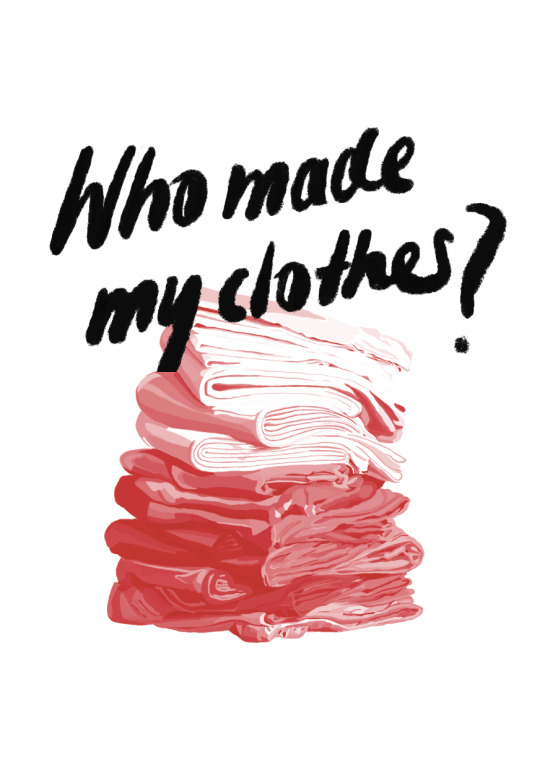
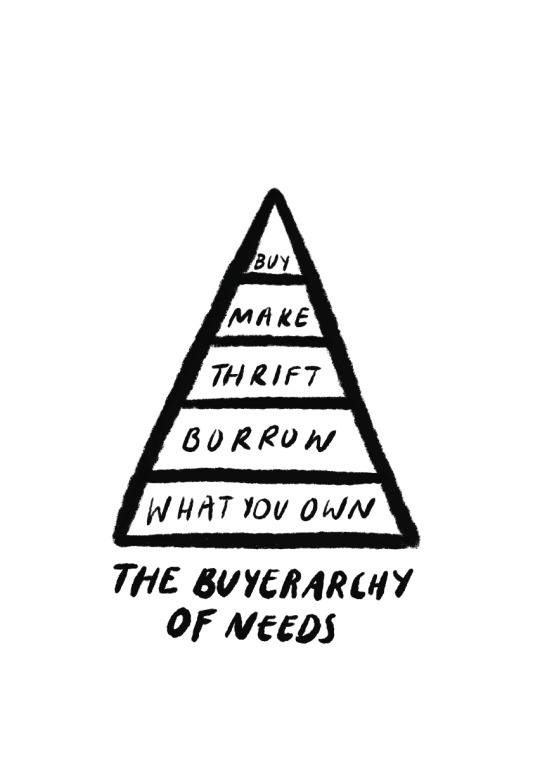

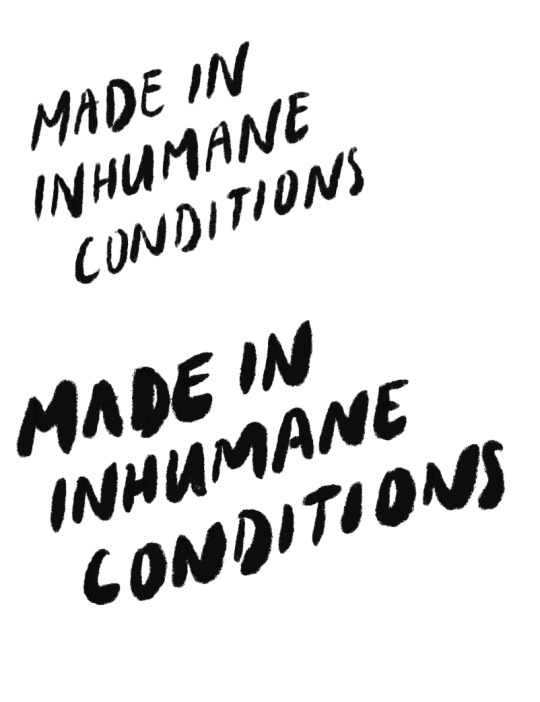

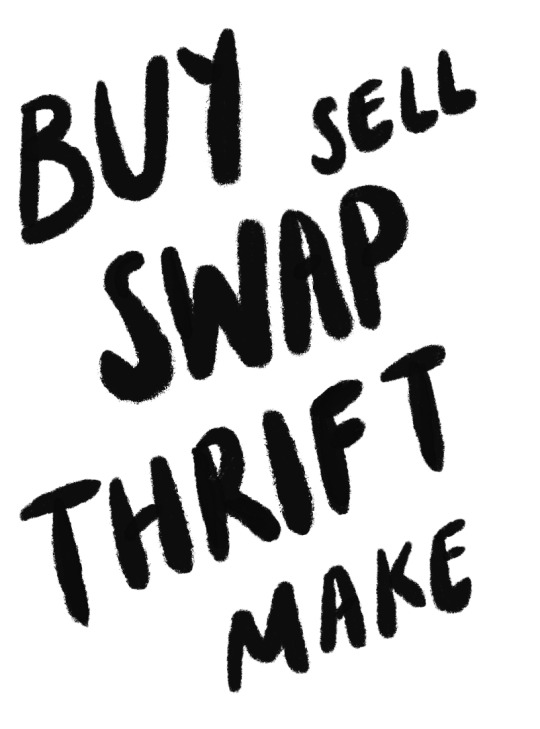
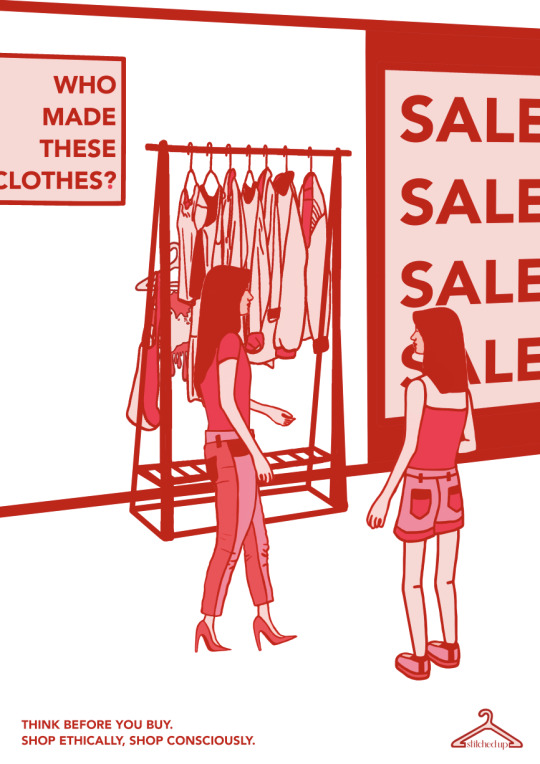
I created these extra assets to add into my campaign. Was thinking I can experiment with these further- maybe use for infographics? or posters? I can use the buyerarchy of needs within my proposal section.
The last poster shown is using the clothing rack and and some people I drew. I had the intention of creating this poster for the reason that so many retailers produce clothes straight for the sale rack, when they were made for so little. I feel like that isn’t super clear so defiantly need to work on making sure that is clearly communicated.
0 notes
Text
Hampir setahun

Kuliah memang membuat saya jarang sekali menulis hal random di tumblr (alesan). Tapi di tengah thesis week yang stressful ini, saya mencoba (kabur dari kenyataan) untuk menulis. Hahaha
Ada beberapa hal yang hampir setahun ini mengubah hidup dan tubuh saya lebih positif dan fun! I will mention those things randomly.
1. Tidak beli baju
Sebenarnya tidak totally sih tapi saya coba menerapkan 'the buyerarchy of needs’. Hasilnya, hidup saya lebih ringan dan tenang. No more rush and hush in the morning mau-pake-baju-apa thingy. Karena baju saya cuma itu-itu aja dan I am happy with them. Senangnya lagi no one judge me like kok kerudungnya itu lagi itu lagi hahahaha. Tapi kalaupun ada, I will be happy to explain. Saya lagi ga mau belanja. Gitu aja. Beberapa hal yang saya beli hanya ketika butuh-banget yaitu jaket winter dan rain coat. Menyenangkannya lagi, kantong sayapun turut aman tentram.
2. Tidak beli barang yang tidak perlu
Nah di luar baju, misalnya kaya pernak pernik gitu sih. Saya coba pisahin karena sebenernya buat yang kenal, saya anaknya ga suka nyimpen barang apalagi kalo kececer di luar. No banget. Semua barang harus masuk lemari dan tertutup. Kalo bisa tuh kamar saya sekosong mungkin hahaha. Alhasil selama di Gron, saya hampir gak pernah beli barang. Beberapa yang saya beli hanya barang habis. Misalnya lilin, saya juga gak tahan sih kalo sama lilin soalnya enak aja kamarnya jadi wangi. Sama beli sprei dan selimut, jadi saya punya tiga selimut buat ganti-ganti. Oh sama tanaman, tapi tanaman di luar kamar sih. Saya coba yang fungsional, maksudnya bisa dimakan. Rosemary, dill, dan parsley. Alhamdulillah mereka tahan, cuma cabe yang mati, sedih banget padahal itu yang paling berharga.
3. Tidak pakai make-up
Ini sih yang paling amazing menurut saya. Saya bukannya yang totally ga pernah pakai make-up ya. Kalau acara formal kaya event Indonesia atau beasiswa gitu saya pakai. Tapi tidak untuk sehari-hari. Hasilnya saya cuma punya lipstick sama concealer doang sekarang. Concealernya juga jarangggg banget dipakenya. Sedang tipe makeup yang lain sudah tidak ada yang saya perbarui. Senang sekali tapi mukanya jadi ringan dan sehat. Bersihinnya juga enggak PR.
4. Pakai skin care
Nah pengganti make-up, saya jadi lebih rajin merawat kulit. Rajin bersihin pagi malem. Saya belajar juga dari teman saya tentang skin care organik. Senangnya skin care kaya gitu lebih murah dan emang bagus banget buat kulit. Kulit saya gak ketergantungan dan normal aja keluar jerawat misal terus ilang lagi. Jadi lebih happy aja dan tenang karena ga pake kimia kimiaan.
5. Food-prep
Bedanya jadi anak kosan di Indo dan di luar adalah, saya wajib untuk memasak. Karena, mau makan apa dong? Gak bisa jajan jajan disini. Tapi senangnya saya jadi hemat dan makan sehat. Awalnya juga super ribet dan time consuming. Lama kelamaan saya jadi keep up with the pace dan tau tips and tricknya.
Apapun itu, saya senang banyak hal positif di hidup saya. Alhamdulillah.
1 note
·
View note
Photo

🛍🌱 Konsumpyramide — Statt jeden Bedarf gleich mit einem Neukauf zu befriedigen, gibt es zahlreiche Alternativen, mit denen wir auf ressourcenschonendere Weise an die Dinge kommen, die wir benötigen. . ⏳ Nutzt lange was ihr schon habt — Viele Neuanschaffungen sind eigentlich gar nicht notwendig, wenn wir genauer darüber nachdenken. Oft tätigen wir Neuanschaffungen aus einer Laune, Bequemlichkeit oder Statusgründen. Nutzen wir hingegen Dinge so lange wie möglich, bringen wir unserem Besitz wesentlich mehr Wertschätzung entgegen und sparen die meisten Ressourcen ein. . 🛠 Repariert was ihr habt — Eine Begleiterscheinung unserer Wegwerfgesellschaft besteht in der schnellen Entsorgung (kaputter) Gegenstände und der schnellen Ersetzung durch Neues. Da der größte Teil des Ressourcenverbrauchs bei der Herstellung von Produkten anfällt (und meist nicht bei ihrer Benutzung), ist es deutlich umweltfreundlicher Dinge im Falle eines Defekts zu reparieren. . 🤝 Leiht aus — Braucht wirklich jeder Haushalt ein Raclette, ein Auto oder eine Bohrmaschine? Dinge zu teilen trägt dazu bei, dass Material und Energie besser genutzt werden und gleichzeitig jeder weniger ungenutzte Staubfänger Zuhause hat. . 🏷 Kauft gebraucht — Gegenstände aus zweiter Hand verbrauchen weder neue Rohstoffe noch Energie, da sie ja bereits hergestellt wurden und damit grundsätzlich nachhaltiger sind als Neuware. Netter Nebeneffekt: Beim Second-Hand-Kauf lässt sich meistens auch erheblich Geld sparen und manchmal auch der ein oder andere Schatz entdecken. . 🛒 Kauft neu — Wenn keine der genannten Alternativen möglich ist und ihr es wirklich wollt, bleibt nur der Neukauf. Doch auch hier habt ihr noch viele Möglichkeiten euren Konsum nachhaltiger zu gestalten. Kauft daher möglichst regional, fair, ökologisch, zeitlos, mit guter Qualität und nur, wenn es euch wirklich glücklich macht! . ➡️ Reflektiert ihr bevor ihr etwas kauft? Wie geht ihr vor bevor ihr euch entscheidet etwas Neues zu kaufen? Habt ihr vielleicht noch Tipps wie man weniger konsumieren kann? . (Darstellung in Anlehnung an „Buyerarchy of Needs“ von @SarahLazarovic) (hier: Stuttgart, Germany) https://www.instagram.com/p/CHlSD0GnO_y/?igshid=iii9msvvkzli
0 notes
Text
April 24, 2020
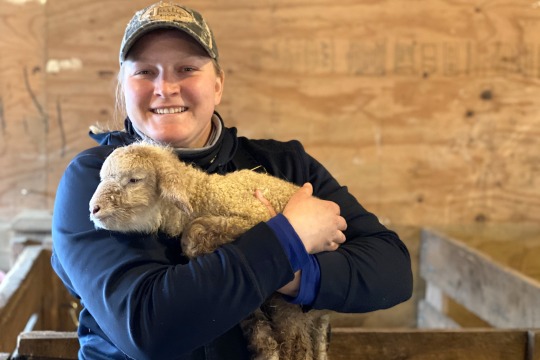
Photo: Farm intern Bri with a newborn lamb.
North Country School was founded in 1938 with a deep commitment to community—both within our own campus, as well as our larger global community. A respect for and responsibility to one another informs all that we do, from our daily barn chores and large-scale composting efforts to our collaborative artwork and social-justice themed theater productions. This past week has highlighted some of the ways we at NCS strive to support one another and connect to the larger world, and the ways we’ve had to adapt those goals since the distance between us has widened dramatically over the past few months.
This week the ewes in our barnyard gave birth to the first newborn lambs of the year. What is usually an all-community activity has transformed into a long-distance celebration of the hard work and thoughtful care provided by our farm staff to our barnyard creatures. We also celebrated Earth Day together as a community, though the event looked different than it has in recent years. With the assistance of technology, we were able to join together with the extended NCS family to celebrate our shared earth, and discuss ways we can continue to care for the planet. We were encouraged to see similar events put on by thoughtful communities all around the globe, and are inspired by the creative ways people continue to come together despite the new hurdles we face throughout these times apart.
Please keep sending us your photos, and we will add them to our NCS at Home: Spring 2020 photo library. Email photos to Becca Miller at [email protected].
Note: Our campus is closed to all students for the remainder of the school year, with the exception of the international students who remained here during spring break, rather than returning to their home countries during the early stages of the outbreak. These 18 students, along with our houseparents and faculty, are staying on campus and enjoying outdoor adventures in the contiguous wilderness during this time. They have been and will continue to take appropriate safety and prevention measures.
CREATIVITY AND CONNECTION



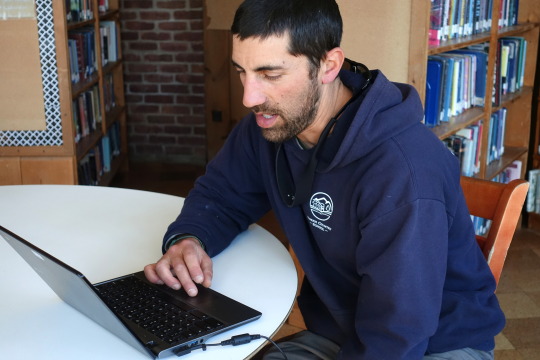

Top: Larry teaches Earth Science class in winter gear. Middle 1: Larry’s daughter, NCS 8th-grader Ella, helps him film a glacier lab. Middle 2: 8th-grader Eliza does her glacier lab at home. Middle 3: Elie teaches Spanish class from the NCS library. Bottom: Elie uses NCS alum Autumn’s Spanish children’s book as an example for the class.
As we work our way through the spring term, NCS teachers are finding new ways to engage students in dynamic lessons. This week in Earth science class, Larry—along with some help from his daughter and NCS 8th-grader Ella—got outside to demonstrate a glacier lab to his class on Zoom. The students then participated in their own lab from their homes around the world, freezing bags of sediments, ice cubes and water (using other substances if they didn’t have access to those resources). They then pushed their "glacier" around in their yards to examine how the object’s movement affected the ground beneath it. Each student drew their observations, which included seeing grooves, striations, erratics, and broken chunks of ice destined to be kettle ponds. In Elie’s Spanish class, students are beginning an ongoing project where they will be writing a children’s book in Spanish that takes place in a country of their choice. To show the class what their end product could look like, Elie read through an example made by 2018 NCS graduate Autumn about a pair of best friends living in Guatemala.



Top: Noni talks about NCS sustainability for Earth Day Town Meeting. Middle: Earth Day Town Meeting participants. Bottom: Buyerarchy of Needs screenshot from Earth Day presentation. Photo credit: Sarah Lazarovic.
Though we are currently separated by great distances, North Country School’s focus on community remains a crucial part of everyday life. This week we continued to adapt to the new structure of our lives by celebrating Earth Day together with the extended NCS family despite the space between us. In a morning Town Meeting event, faculty, staff, students, and families joined together on Zoom to talk about the significance of Earth Day, and the many ways we can care for the world around us. The gathering (which was attended by over 100 members of our extended community) featured passionate talks and poignant readings by many NCS adults, including a history of NCS’s expansive sustainability efforts recounted by art teacher Noni—the granddaughter of NCS founders Walter and Leonora Clark—and some helpful ideas on how to appreciate more and waste less by English teacher Melissa.
ART AND ADAPTATION


Top: NCS student work from the Lake Placid Center for the Arts’ Annual High School Art Show. Bottom: Tony practices piano for music class.
Like many aspects of life in this moment in time, art and creative expression looks a bit different for our NCS students than it did only months ago, but as the old adage goes, necessity is the mother of invention. Our need to express ourselves and create beauty remains unchanged, though the methods are ever-evolving both on the NCS campus and in our surrounding community. This past week we learned that many of our students had artwork accepted into the Lake Placid Center for the Arts Annual High School Art Show. Since visitors can’t view these works in person this year, the Center has changed the show into a digital exhibit that showcases the vibrant and powerful work created by talented students from around the North Country region. To see the NCS photographs, sculptures, paintings, drawings, and ceramic pieces that were selected for this annual show, click here.
Our musical students have also been adapting alongside teacher Joey, working on their own individual skills and collaborative projects from their own homes and in The Walter Breeman Performing Arts Center (WallyPAC) on the NCS campus. This week, Tony spent time in the NCS music studio to continue to work on his section of a group piece that will be showcased later in the term.
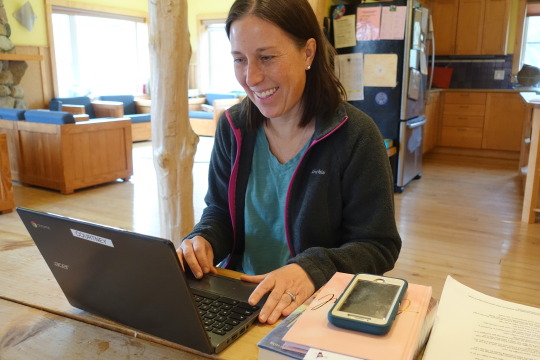


Top: Courtney teaches theater class. Middle: Through the Looking Glass script. Bottom: Sally rehearses her lines with Courtney over Zoom.
Though students will not be returning to the North Country School campus for our annual spring production of Alice in Wonderland, the show must go on. This week theater teacher Courtney continued her classes with the actors in the show, working through dialogue with individuals and groups over Zoom. Students Sally and Jessica ran through some of their lines for their roles as the White Queen and Alice, respectively. The production, which features five different students playing the titular role of Alice, will be recorded in pieces in students’ homes and edited together into a full-length show that will be shown at the end of the academic year.
A PLACE TO PLAY



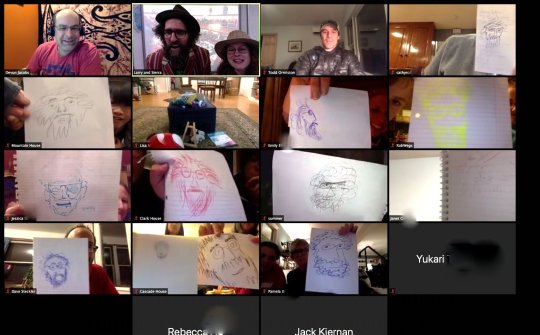
Top: Cascade House plays badminton in the Pavilion. Middle 1: Koga plays in the Upper Field. Middle 2: Larry and Sierra host the Saturday Night Activity. Bottom: Saturday Night Activity participants show their work over Zoom.
Students and teachers on the North Country School campus found time for active play and lighthearted silliness this week. The students of Cascade House spent several out-times in the Pavilion playing some competitive ping pong, with sisters Jessica and Rebecca going head-to-head for several rounds, while the students living in Mountain House and Clark House played games of soccer, tennis, and Frisbee on the Upper Field by the Lake Hill. As temperatures continue to warm we hope to spend more time by the lake, paddling in canoes and relaxing at the boathouse.
This week marked the third remote Saturday Night Activity—part of our Connecting to the Community series. Teachers Larry and Sierra hosted the Reverse Auction activity, with students and adults participating via Zoom from their on-campus and off-campus homes. The scavenger-hunt style event was a huge success, with the students of Cascade House—clearly the team to beat—winning for the third week in a row!
NCS AT HOME

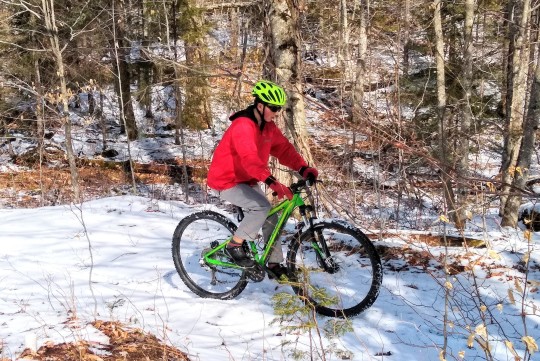

Top: Sisters Dominica and Kalina practice with their ice skating team via Zoom. Middle: 7th-grader JT bikes. Bottom: 7th-grader Colton hikes Balanced Rocks.
We were excited to see more updates from our students at home this week. We’re especially glad to see all the creative ways our community members are staying active and healthy during this time, whether it be inside or outdoors. Competitive ice skaters Dominica and Kalina have been training remotely with their teammates and coaches in Los Angeles from inside their North Country home. Though they are not able to train on the ice, the girls have been working hard on their jumping, conditioning, strength, flexibility, and ballet skills in their garage studio. 7th-graders JT and Colton have also been staying active with their respective families, spending afternoons and weekends biking around their local wooded trails and hiking through the wilderness to beautiful vistas.




Top: 9th-grader Jessica makes cream puffs. Middle 1: 8th-grader Hanna does her Earth science lab at home. Middle 2: 6th-grader Samantha attends class from home. Bottom: 6th-grader Will and his brother, Leo, make sticky buns from the “What’s Cooking at NCS and Camp Treetops?” blog.
NCS students have also been practicing their hobbies and schoolwork from their homes around the world. The students living in Cascade House have been experimenting with baking under the guidance of their houseparent Meredith. This past week the group continued working on their tasty kitchen creations by baking up a batch of homemade cream puffs. Students in Larry’s Earth science class sent photo-updates of their glacier lab, while 6th-grader Samantha sent along a picture of her working alongside a furry friend. NCS 6th-grader Will, along with his brother and Camp Treetops camper Leo, spent some time this week preparing a recipe from the What’s Cooking at NCS and Camp Treetops? Blog. Their finished sticky buns, made using Head of Kitchen Paulette Peduzzi’s recipe—a favorite for campers and students alike—looked like the perfect sweet morning treat.
SIGNS OF SPRING



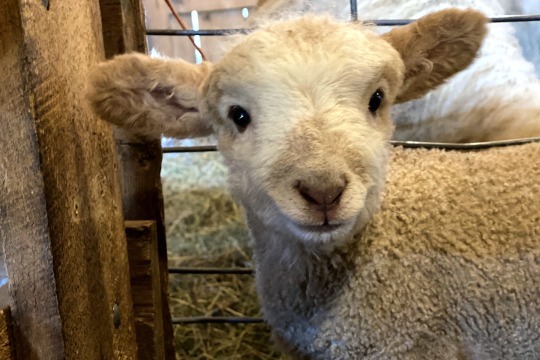

Top: A rooster enjoys the warm weather. Middle 1: Horses in the sunshine. Middle 2: Newborn lamb twins with their mother. Middle 3: A newborn lamb. Bottom: Farm intern Nick with a newborn lamb.
Sunny skies have been drawing our farm animals into the outdoors lately, and Barn Manager Erica has been sending delightful updates from our different animal spaces throughout the week. Over in the chicken coop, the roosters and hens have been enjoying their time out in the yard, finding bugs and eating scratch, while the horses practiced social distancing while they posed for their group shot.
The real news from the farm this week was the start of our much-anticipated, and always joyful, lambing season. Each spring, as the birds return back to our feeders and the frog pond becomes a riot of peeps and croaks, we welcomed the arrival of our lambs. Lambing season at North Country School has always been a community event, with students witnessing our ewes giving birth and groups there to receive and care for newborn creatures as they join the world. The start of lambing this year has been a bittersweet time, as we are not able to join together and help each other in the ways we’d hoped, but Barn Manager Erica, along with farm interns Nick and Bri, have been caring for our barnyard creatures and sending us joyful updates each day. So far we have five new lambs in our flock, and are eagerly awaiting signs of labor from the remaining seven pregnant ewes. While we miss being a part of this special season and lending a hand on the farm, we are grateful to the barn staff for their thoughtful care and tireless work on behalf of our many barnyard animals.
Join us as we watch our flock live via Lamb Cam, streaming from our sheep barn throughout lambing season.
We hope that you and your loved ones are staying safe and healthy, and that your communities are caring for and supporting one another. We will continue to update you about our community throughout this time, and encourage you all to reach out to us as well.
CONNECTING WITH OUR COMMUNITY:
Mondays: Check our Facebook page every Monday for a video from our School Counselor, Lauren, on tips for getting through this challenging time.
Tuesdays: Creature Query- Barn Manager Erica Burns will be answering questions about the animals on our farm using fun and educational videos. Last week Erica taught us how to prepare our sheep’s wool for spinning. Check it out on our Facebook page.
Wednesdays: What’s Cooking at NCS and Camp Treetops?- Edible Schoolyard instructor Elie Rabinowitz, along with other community members, will provide simple recipes and cooking resources you can use to prepare delicious meals at home with your families. This past week Head of Kitchen Paulette Pedizzi shared her much-loved sticky bun recipe. Check out all of the recipes on Facebook and on Tumblr.
Thursdays: Birding with Jack- 6th grade English teacher Jack Kiernan will offer the NCS community an opportunity to connect through the world of birds by providing the resources to become familiar with birds that our community is seeing around the globe. If you are out for a walk or sitting at home, looking out the window, take a moment to log the birds you see with the NCS eBird account. Last week Jack shared a video that featured a Song Sparrow at the pond on campus. Check it out on our Facebook page.
Fridays: Check our Facebook page every Friday for a video featuring a Japanese mini-lesson by teacher Meredith Hanson. Last week Meredith shared some wisdom from around the world as she read a passage from the "Dao De Jing" by Lao Tzu.
Saturdays: The NCS Saturday Night Activity- Every Saturday at 8 p.m., NCS teacher Larry Robjent, along with other NCS faculty, will be hosting fun activities similar to those typically held on campus with students. Participate live from home with your own families. Last week, Larry and Sierra ran a reverse auction, and this coming Saturday, April 25, will feature NCS/CTT Trivia!
For more information about the #ThisWeekAtNCS blog, contact Becca Miller at [email protected].
For general school information, call 518-523-9329 or visit our website: www.northcountryschool.org
0 notes
Photo
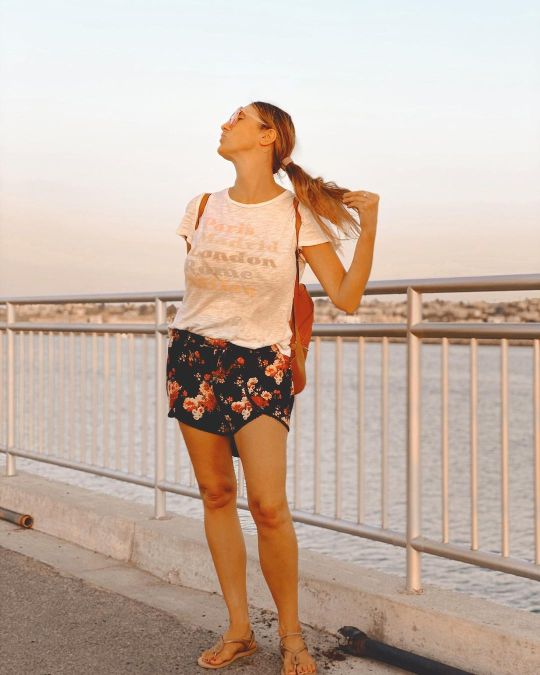
This outfit is comfortable but how socially conscious is it? In my latest Becoming Woke video, I grade it a D.😔Check out http://bit.ly/CateStarYouTube (link in bio!) for the latest episode of Becoming Woke where I use the Hierarchy of Needs, the Buyerarchy of Needs and the 3 Tenets of Socially Conscious Shopping to come up with a rubric for grading how #sociallyconscious my summer packing was! (at Marina Peninsula) https://www.instagram.com/p/CHQrfTmHhNC/?igshid=zcorhloxsfbn
0 notes
Text
I'm cobbling together a whole life unfucking/living strategy: from Marie Kondo for decluttering and sparking joy, unfuck your habitat for cleaning and tidying, the buyerarchy of needs for when/if I do need to acquire stuff, plus And Then We Saved for budgeting planning etc (also tips from the book No Spend Year).
What else? Tips on living small from tiny house shows and the blog A Small Life. I used to listen to the minimalists podcasts too although I've moved on from that a bit.
Will keep learning more I'm sure but it's interesting to see how I'm filling in the bits of knowledge eg Marie Kondo doesn't say much about buying/NOT buying, she's so confident you just won't once your space is tidy (she hasn't met me and my emotional spending ways!) so then I've found resources to fill that part in, which ties into the money stuff.
Love learning from other people on a similar process and talking about this stuff. It's really helpful.
Excited to see where the journey will take me next and it's all like overlapping layers. I have a little more to go on konmari (mainly sentimental), meanwhile I've been reading no spend year and the Unfuck Your Habitat book and I'm starting to put some of those strategies into place.
4 notes
·
View notes
Link
Buyerarchy Of Needs - Adapting Maslow's Heirarchy To Save Money #cv #selectioncriteriawritingservice #governmentjob #resume https://rplg.co/ef8f8420
0 notes
Photo
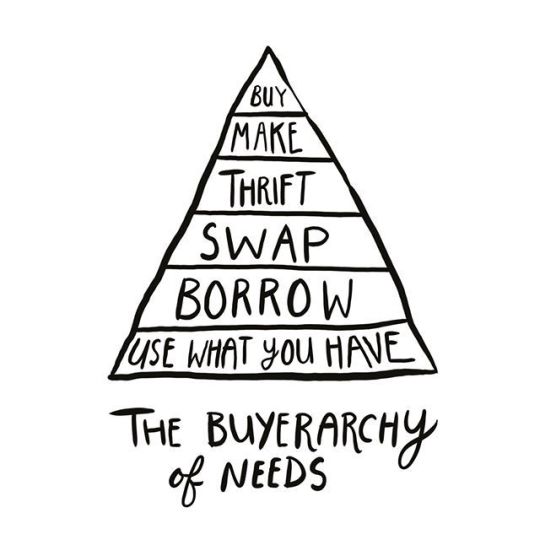
Shop according to the buyerarchy of needs, from Fashion Revolution https://ift.tt/2NpXD9X
0 notes